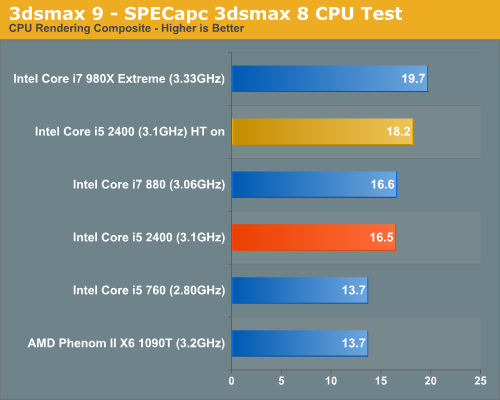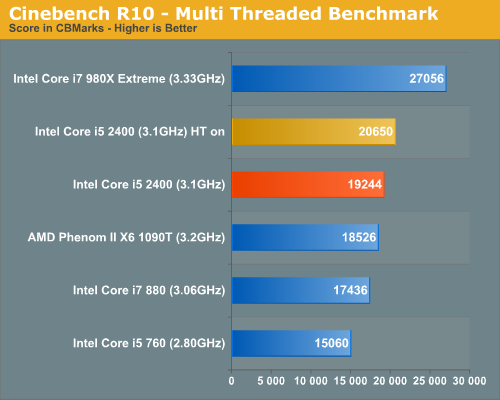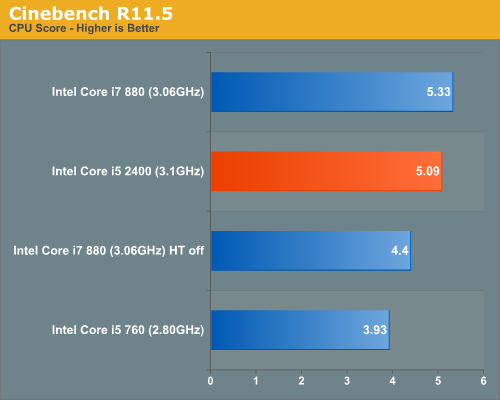The Sandy Bridge Preview
by Anand Lal Shimpi on August 27, 2010 2:38 PM EST3dsmax 9 - SPECapc 3dsmax CPU Rendering Test
Today's desktop processors are more than fast enough to do professional level 3D rendering at home. To look at performance under 3dsmax we ran the SPECapc 3dsmax 8 benchmark (only the CPU rendering tests) under 3dsmax 9 SP1. The results reported are the rendering composite scores:

This is another one of those situations where the Core i5 2400 without Hyper Threading is able to perform on par with the Core i7 880 with Hyper Threading. Compared to the i5 760 it’s 20.5% faster.
With Hyper Threading enabled, the Core i5 2400 is actually dangerously close to the 6-core 980X. Whatever Intel has done to Sandy Bridge's FP is big.
Cinebench R10
Created by the Cinema 4D folks we have Cinebench, a popular 3D rendering benchmark that gives us both single and multi-threaded 3D rendering results.

Cinebench was particularly surprising because it gives us a good opportunity to look at single threaded FP performance. Compared to a similarly clocked Lynnfield, Sandy Bridge can deliver 11% better performance. Compared to a similarly positioned Lynnfield, Sandy Bridge is about 20% faster. Note that this is without turbo enabled. The retail 3.1GHz chip should turbo up to 3.4GHz in this test, giving it a 9.6% frequency boost.
In the multithreaded test Sandy Bridge’s per-core performance is even better than Lynnfield with HT enabled.

I also ran a few numbers using Cinebench R11.5. I didn’t have the opportunity to test the i5 2400 with HT enabled in this test so I measured performance of the i7 880 with HT enabled/disabled to compare per-thread performance.

Sandy Bridge's FP performance is very good. Clock for clock we see a 15.6% improvement over Lynnfield (4C/4T vs. 4C/4T). Compared to the proposed similarly priced Core i5 760, the i5 2400 would be 29.5% faster.
POV-Ray 3.73 beta 23 Ray Tracing Performance
POV-Ray is a popular, open-source raytracing application that also doubles as a great tool to measure CPU floating point performance.
I ran the SMP benchmark in beta 23 of POV-Ray 3.73. The numbers reported are the final score in pixels per second.

The similarly positioned/priced Core i5 760 is beat by 17%. There’s no replacement for more cores/threads however as the i7 880 and X6 parts both pull ahead. Turn on HT to level the playfield (at least within Intel) and Sandy Bridge is 15% faster than Lynnfield.










200 Comments
View All Comments
DanNeely - Friday, August 27, 2010 - link
Maybe, but IIRC Apple's biggest issue with the Clarkdale platform on smaller laptops was wanting to maintain CUDA support across their entire platform without adding a 3rd chip to the board, not general GPU performance. Unless the Intel/nVidia lawsuit concludes with nVidia getting a DMI license or Intel getting a CUDA license this isn't going to change.Pinski - Saturday, August 28, 2010 - link
I don't think it has anything to do with CUDA. I mean, they sell Mac Pros with AMD/ATI Cards in them, and they don't support CUDA. It's more of OpenCL and high enough performance. However, just looking at these new performance, I'm willing to say that it'll be the next chip for the MBP 13" easily.Pinski - Saturday, August 28, 2010 - link
Well, wait never mind. Apparently it doesn't support OpenCL, which basically puts it out of the picture for Apple to use.starfalcon - Saturday, August 28, 2010 - link
Hmm, they really want all of the systems to have OpenCL?I don't have OpenCL and I don't care at all and I have CUDA but have only used it once.
320M doesn't even have OpenCl does it?
Seems like it would be ok for the less expensive ones to have Intel graphics and the higher end ones to have CUDA, OpenCL, and better gaming performance if someone cares about those.
They'll keep on upgrading the performance and features of Intel graphics though, who knows.
Veerappan - Thursday, September 2, 2010 - link
No, just ... no.Nvidia implements an OpenCL run-time by translating OpenCL API calls to CUDA calls. If your card supports CUDA, it supports OpenCL.
The 320M supports OpenCL, and every Apple laptop/desktop that has shipped in the last few years has as well.
A large portion of the motivation for OS X 10.6 (Snow Leopard) was introducing OpenCL support.. along with increasing general performance.
There is a large amount of speculation that OS X 10.7 will take advantage of the OpenCL groundwork that OS X 10.6 has put in place.
Also, in the case that you have a GPU that doesn't support OpenCL (older Intel Macs with Intel IGP graphics), Apple has written a CPU-based OpenCL run-time. It'll be slower than GPU, but the programs will still run. That being said, I highly doubt that Apple will be willing to accept such a performance deficit existing in a brand new machine compared to prior hardware.
Penti - Saturday, August 28, 2010 - link
It has more to do with nVidia's VP3 PureVideo engine which they rely on for video acceleration. It's as simple as that.Which is why they only find their place in the notebooks. It's also a low-end gpu with enough performance to say run a source game at low res. And they have more complete drivers for OS X.
CUDA is a third party add on. OpenCL isn't.
burek - Friday, August 27, 2010 - link
Will there be a "cheap"(~$300) 6-core LGA-2011 replacement for i7 920/930 or will Intel limit the 6/8 cores to the high-end/extreme price segment ($500+)?DJMiggy - Friday, August 27, 2010 - link
yea I doubt that will happen. It would be like trying to SLI/crossfire an nvidia to an ati discrete. You would need a special chip like the hyrda one.DJMiggy - Friday, August 27, 2010 - link
Hydra even. Hydra Lucid chip.Touche - Friday, August 27, 2010 - link
Questionable overclocking is bad enough, but together with..."There’s no nice way to put this: Sandy Bridge marks the third new socket Intel will have introduced since 2008."
"The CPU and socket are not compatible with existing motherboards or CPUs. That’s right, if you want to buy Sandy Bridge you’ll need a new motherboard."
"In the second half of 2011 Intel will replace LGA-1366 with LGA-2011."
...it is just terrible!
I'll definitely buy AMD Bulldozer, even if it ends up a bit slower. At least they have some respect for their customers and an ability of forward thinking when designing sockets (actually, Intel probably has it too, but just likes to milk us on chipset purchases also). And I am no fanboy, 4 of my 7 PC's are Intel based (two of those 4 were my latest computer purchases).